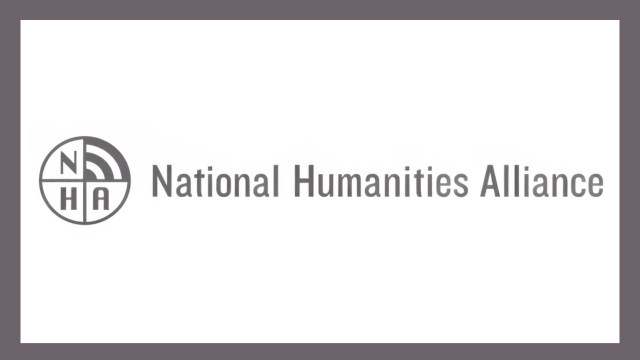
A 48-page report released in June by the National Humanities Alliance focuses on recruiting, engaging and supporting students from historically underrepresented groups in humanities programs at both two-year and four-year US higher education institutions.
The report, titled, “Expanding Access to Undergraduate Humanities Education: Models and Strategies,” defined “historically underrepresented groups” as “racial and ethnic groups,” first-generation college students, community college transfer students, Pell Grant recipients, and recent immigrants. The report pays particularly close attention to Historically Black Colleges & Universities (HBCUs). LGBTQ+ students and students with disabilities were not included in the report.
The National Communication Association is a member of the National Humanities Alliance.
This 2024 report, written by NHA Director of Undergraduate Initiatives Scott Muir, builds on the NHA’s 2021 report, “Strategies for Recruiting Students in the Humanities: A Comprehensive Resource.” In Fall 2021 and Spring 2022, the NHA distributed a survey to more than 1,000 institutions and received over 300 responses, which were reviewed to identify barriers facing humanities program enrollment by historically underrepresented groups and humanities initiatives. This report is almost entirely composed of case studies of widely varying initiatives discussed in the survey responses, and almost entirely in English and/or history departments. Barriers were organized under broadly defined headings of “revamping curricula to resonate with students,” “alleviating students’ concerns about job prospects,” “addressing faculty diversity and combating cultural isolation,” and “making the humanities more legible to students.”
Humanities initiatives identified as directly engaging/supporting students from historically underrepresented groups are:
- “The Center for American Indian Studies at the University of Washington has created robust pathways for Native students through an expansive set of initiatives that foster a more inclusive environment on campus and encourage these students to participate in humanities courses and research projects.”
- “The Kickstart Program—a summer bridge design by English and writing faculty at Eastern Oregon University to support students from historically underrepresented groups, particularly Pacific Islanders—uses the tools of the humanities to support students’ successful transition to the campus and immerse them in the history and culture of the region.”
- “A new B.A. program in Writing for Diversity and Equity in Theater and Media (WDETM) at Pace University integrates intensive writing instruction, in-depth humanistic exploration of social justice issues, and hands-on training for a variety of careers in theater and media.” (This program was featured in a panel discussion at the 2023 NHA conference.)
- “The Institute for Arts and Humanities at the Massachusetts College of Liberal Arts supported arts and humanities programming, DEI work, and community engagement to empower students from historically represented groups to make their voices heard.”
- “The University of California, Los Angeles (UCLA) has developed strategies that welcome all students to the humanities, support first-generation students, and train faculty and graduate students in inclusive pedagogies.”
- “A grant from the National Endowment for the Humanities (NEH) helped faculty at Vanguard University create a summer bridge program that illustrated the practical and personal value of the humanities for a majority-Latinx student population.”
Humanities initiatives identified as targeting a broader student market and successful in increasing enrollment by one or more historically underrepresented student groups are:
- “The history department at James Madison University has increased its majors and minors through curricular reforms, advocacy concerning career pathways, and marketing efforts, all of which have made studying history more attractive to first-generation students.”
- “The English department at the University of Pittsburgh reversed a 50% decline in majors and attracted a more diverse student population by creating a range of innovative programs that prepare students for careers in media and communication.”
- “The University of South Carolina-Union (USC-Union) has attracted more Black and Latinx students to the institution and increased enrollments in the humanities by expanding dual enrollment offerings for high school students and offering humanities courses for students pursuing nursing degrees.”
- “Aurora University’s English department sustained a healthy pipeline of majors as the university’s student population diversified by proactively articulating career pathways and reforming its curriculum to better represent students’ identities and experiences.”
- “Through outreach to underserved students, concrete support, and innovative curricula emphasizing civic engagement, Cuyahoga Community College is cultivating an inclusive humanities pipeline that prepares students for leadership.”
- “The High Impact Humanities Initiative at the University of Massachusetts, Boston has generated 24 timely humanities gen ed courses that are shifting perceptions of the value of the humanities among a highly diverse student population.”
- “The College of Humanities at the University of Arizona has achieved steady growth and attracted a diverse student population by investing in inclusive recruitment strategies and innovative curricula.”
- “The Engage Humanities Initiative at the University of Illinois-Chicago empowers students to pursue their personal, professional, and civic goals through community engagement and mentored research projects.”
The report’s case studies on each of these humanities initiatives provides details such as course names, lists of goals, university departments and offices involved, but rarely includes quantitative evidence of their impacts or even how many students were involved, whether 10, 100, or 1,000. The report also does not clarify why the initiatives discussed in detail are almost entirely limited to English and/or history departments, despite the potential applicability of these strategies to other fields such as communication studies, non-English languages/literature, philosophy, fine and performing arts. The exclusion of some historically underrepresented groups such as LGBTQ+ students and students with disabilities is not directly addressed in the report. Finally, the report presents only entirely favorable stories about successful initiatives, while lacking helpful information about mistakes to avoid or failed initiatives.
The report is freely available at: https://nhalliance.org/wp-content/uploads/2024/06/Expanding-Access-Report-FINAL.pdf

